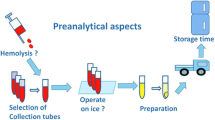Abstract
The relative merits of plasma and serum in blood analysis are reviewed. The expression ‘plasma concentration’ is often used in the literature, although serum samples have been taken. In most cases serum and plasma concentrations of analytes are the same. The choice depends mostly on the policy of the hospital or the availability of the test tubes in the ward. Some of the advantages of plasma over serum are large volume, no delayed clotting, less risk of haemolysis. In addition, the sample is often suitable for both whole blood and plasma monitoring. Some of the disadvantages of plasma over serum are the (unknown) influence of the anticoagulant on the assay, on the protein binding and on the stability of the sample, the (unknown) influence of additives or impurities in the anticoagulants on the assay and on the concentration, the risk of the formation of small clots and dilution of the sample.
Similar content being viewed by others
References
Casarett LJ, Doull J. Toxicology. The basic science of poisons. New York: Macmillan Publishing Company, 1975.
Moffat AC, ed. Clarke's isolation and identification of drugs. 2nd ed. London: The Pharmaceutical Press, 1986.
Beermann B, Groschinsky-Grind M. Clinical pharmaco-kinetics of diuretics. Clin Pharmacokinet 1980;5:221–45.
Keown PA, Stiller CR, Stawecki M, McMichael J, Howson W. Pharmacokinetics and interactions of ciclo- sporin. In: Schindler R, ed. Ciclosporin in autoimmune diseases. Berlin: Springer-Verlag, 1985:39–42.
Uges DRA, Van der Paauw HJW. Alcohol, de bloed-proef en de contra-expertise [Alcohol, blood test and counterexpertise]. Ned Forens Tijdschr 1982;2:7–9.
Maguire KP, Burrows GD, Norman JR, Scoggings BA. Blood plasma distribution ratios of psychotropic drugs. Clin Chem 1980;26:1624–5.
Linnoila M, Dorrity F, Jobson K. Plasma and erythrocyte levels of tricyclic antidepressants in depressed patients. Am J Psychiatry 1978;135:557–61.
De Vries EGE, Greidanus J, Mulder NH, et al. A phase 1 pharmacokinetic study with 21-day continuous infusion of epirubicin. J Clin Oncol 1987;5:1445–51.
De Vries EGE, Greidanus J, Mulder NH, et al. A phase 1 and pharmacokinetic study with 21-day continuous infusion of mitoxantrone (MX). Am Soc Clin Oncol 1988;7:58.
Smits RV, Stewart JT. Textbook of biopharmaceutic analysis. Philadelphia: Lea & Febiger, 1981:3–16.
Toseland PA. Samples and sampling. In: Moffat AC, ed. Clarke's isolation and identification of drugs. 2nd ed. London: The Pharmaceutical Press, 1986:111–7.
Hichs JA, Iosefsohn M. Another physician's office analyser: the Abbott vision evaluated. Clin Chem 1987;33:817–9.
Walters MI, Roberts WH. Gentamicin/heparin interactions: effects on two immunoassays and on protein binding. Ther Drug Monitor 1984;6:199–202.
Meyers DR, DeFehr J, Bennett WM, Porter GA, Olsen GD. Gentamicin binding to serum and plasma proteins. Clin Pharmacol Ther 1978;23:356–60.
Cipolle RJ, Zaske DE, Crossley K. Gentamicin/tobramycin. Therapeutic use and serum concentration monitoring. In: Taylor WJ, Finn LA, eds. Individualizing drug therapy. 1. New York: Frank Cross Townsend Inc., 1981:138.
Dube LM, Ho-Ngoc A, Davies RF, Beaulands DS, Mousseau N, McGilveray IJ. Influence of protamine on heparine induced increases of lidocaine free fraction. Res Commun Chem Pathol Pharmacol 1983;42:401–15.
Pearce GA, Brown KF. Heat inhibition ofin vitro lipolysis and14C ibuprofen protein binding in plasma from heparinized uraemic subjects. Life Sci 1983; 33:1457–66.
Naranjo CA, Sellers EM, Khouw V, Alexander P, Fan T, Shaw J. Variability in heparin effect on serum drug binding. Clin Pharmacol Ther 1980;28:545–50.
Schulz P, Abang A, Giacomini JC, Blaschke TF, Giacomini KM. Effect of heparin on the red blood cell-to-plasma concentration ratio of diphenylhydantoin and prazosin. Ther Drug Monitor 1983;5:497–9.
Whelpton R. Tricyclic antidepressants and neuroleptics. In: Curry AS, ed. Antalytical methods in human toxicology. Part 1. Weinheim: Verlag Chemie, 1985: 139–58.
Flanagan RJ, Widdop B. Clinical toxicology. In: Curry AS, ed. Analytical methods in human toxicology. Part 1. Weinheim: Verlag Chemie, 1985:37–66.
Froentjes W, Schute JB, Strengers Th, Verwey AMA. Analytisch-chemische aspecten van de wijziging van de Wegenverkeerswet (11) [Analytical and clinical aspects of the change in the Traffic Act (11)]. Pharm Weekbl 1976;111:349–62.
Werk EE jr. Interference of heparin containing benzyl alcohol in the fluorometric determination of plasma corticosteroids. J Clin Endocrinol 1967;27:1350.
Foley B, Johnson SA, Hackley B, Smith JC jr, Halsted JA. Zinc content of human platelets. Proc Soc Exp Biol Med 1968;128:265–9.
Keyzer JJ, Oosting E, Wolthers BG, Muskiet FAJ, Hindriks FR, Van der Slik W. Zinc in plasma and serum: influence of contamination due to the collection tubes. Pharm Weekbl [Sci] 1983;5:248–51.
Carmel R. Vitamin B12-binding proteins in serum and plasma in various disorders. Effects of anticoagulants. Am J Pathol 1978;69:319–25.
Kubasik NP, Sine HE. Results for serum and plasma compared in 15 selected radioassays. Clin Chem 1978;24:137–9.
Huizinga JR, Gips CH. Evaluation of the UV-340 spectrophotometric determination for pseudocholin-esterase activity (EC 3.1.1.8) in human serum. J Clin Chem Clin Biochem 1987;25:161–5.
Smits RV, Stewart JT. Microbiologic assay methods. In: Textbook of biopharmaceutic analysis. Philadelphia: Lea & Febiger, 1981:249–59.
Author information
Authors and Affiliations
Rights and permissions
About this article
Cite this article
Uges, D.R.A. Plasma or serum in therapeutic drug monitoring and clinical toxicology. Pharmaceutisch Weekblad Scientific Edition 10, 185–188 (1988). https://doi.org/10.1007/BF01956868
Received:
Revised:
Accepted:
Issue Date:
DOI: https://doi.org/10.1007/BF01956868




